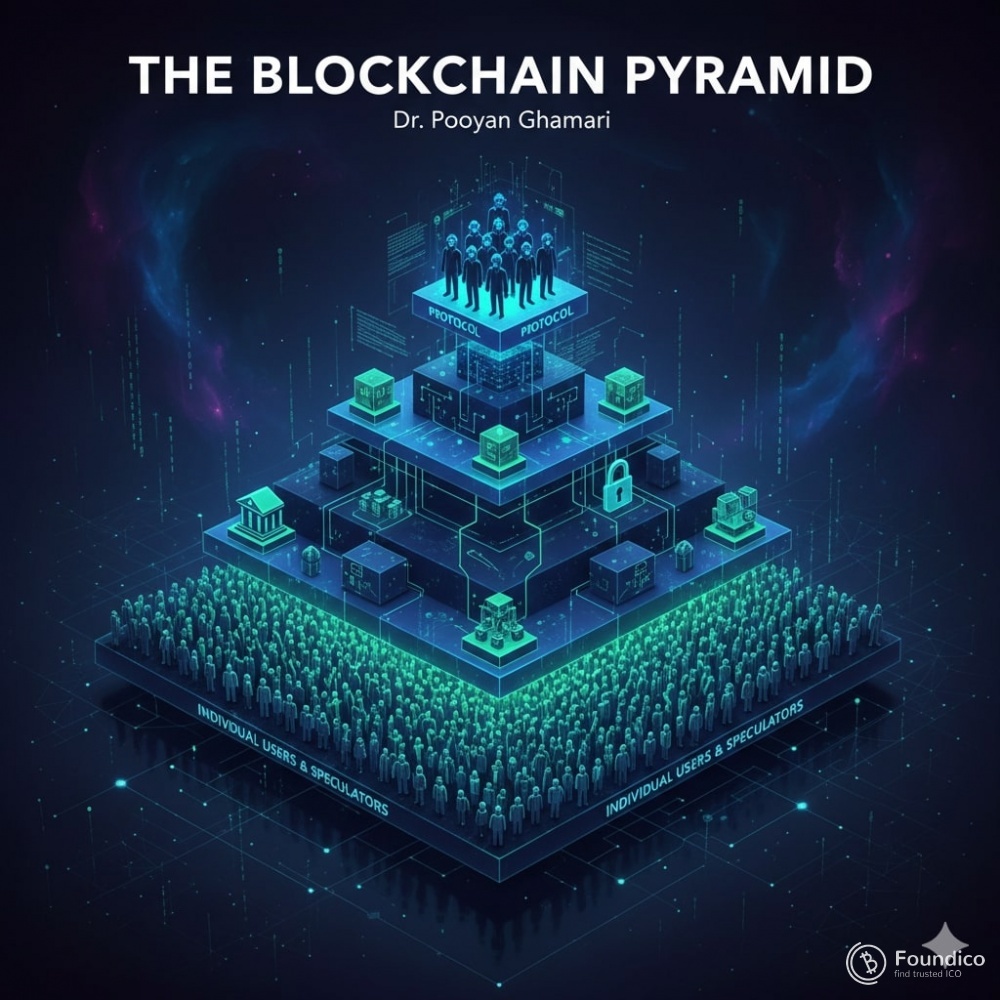The Blockchain Pyramid: How They Built a New Hierarchy in Plain Sight

By Dr. Pooyan Ghamari, Swiss Economist and Visionary Author
The fanfare surrounding blockchain technology often centers on its promises of decentralization, transparency, and a flat, peer-to-peer structure. We were told it would be a technological revolution to dismantle established hierarchies, empower the individual, and distribute power more equitably. Yet, as a Swiss economist closely observing its evolution, I contend that a new, subtle, and perhaps more resilient "Blockchain Pyramid" has been constructed, replacing the old order with a surprisingly familiar new one—all in plain sight.
The Alluring Illusion of Decentralization
The core appeal of blockchain—that no single entity controls the ledger—is a powerful myth. While the ledger itself might be distributed, the crucial levers of power within the ecosystem are not. This new hierarchy is built upon three distinct, interlocking layers:
1. The Apex: Protocol and Core Developers
At the top of the pyramid sit the core developers and protocol founders. These individuals and small groups wield immense, often disproportionate, power over the entire network. They dictate the rules, propose and implement "forks" (changes to the underlying code), and ultimately control the direction of the purportedly decentralized system. Their decisions—which can affect billions in market capitalization—are often opaque to the average user, creating a new, highly technical form of concentrated authority. This is the Code Sovereignty layer, where power is held not by financial capital, but by technical expertise and the ability to dictate the protocol's future.
2. The Mid-Layer: Infrastructure and Intermediaries
Beneath the coders is a powerful layer of intermediaries that have become indispensable for most users. This includes:
-
Exchanges: Centralized cryptocurrency exchanges (CEXs) are the primary on-ramps and off-ramps for fiat currency. They dictate listing rules, set transaction fees, and, in many ways, control liquidity and market access. For most people, interacting with "decentralized finance" still requires trusting a centralized exchange.
-
Miners/Validators: In Proof-of-Work and Proof-of-Stake systems, the consolidation of mining pools or the accumulation of staked tokens gives disproportionate influence to a few large operators. These entities can potentially collude or, through their sheer size, affect the security and transaction finality of the network. This is the Infrastructure Oligarchy.
-
Wallet Providers and Custodians: The growing reliance on user-friendly, non-custodial and even custodial wallet services means a few powerful companies manage the user experience and often hold the ultimate keys to digital assets.
These entities form a powerful, centralized bottleneck that is the functional replacement for traditional banks and brokers. They have simply exchanged one centralized ledger (a bank's database) for a centralized gateway to a decentralized ledger.
3. The Base: The Individual User and Speculator
At the broad base of the pyramid are the millions of individual users and speculators. Their primary role is to provide liquidity, absorb volatility, and, crucially, to believe in the system's narrative. While theoretically possessing the freedom to transact, their limited technical knowledge, small capital base, and reliance on the aforementioned intermediaries place them firmly at the bottom of the power structure. They have little say in protocol governance and are most susceptible to the volatility and the systemic risks controlled by the layers above.
The Path Forward: Recognizing the Structural Flaws
This "Blockchain Pyramid" is not a failure of the technology itself, but a predictable consequence of how human nature and economic incentives interact with a new system. It illustrates a fundamental truth: power is never eliminated, only re-allocated.
To truly achieve the vision of decentralization, we must move beyond the superficial rhetoric and demand transparency and democratic governance at the protocol level. We must recognize that technical decentralization does not automatically equate to economic or political decentralization. As we continue to build this digital future, we must vigilantly ensure that the tools designed to empower the many are not simply used to enrich and re-enforce the power of a new, highly specialized few. The true test of blockchain is not its code, but its structure of control.
